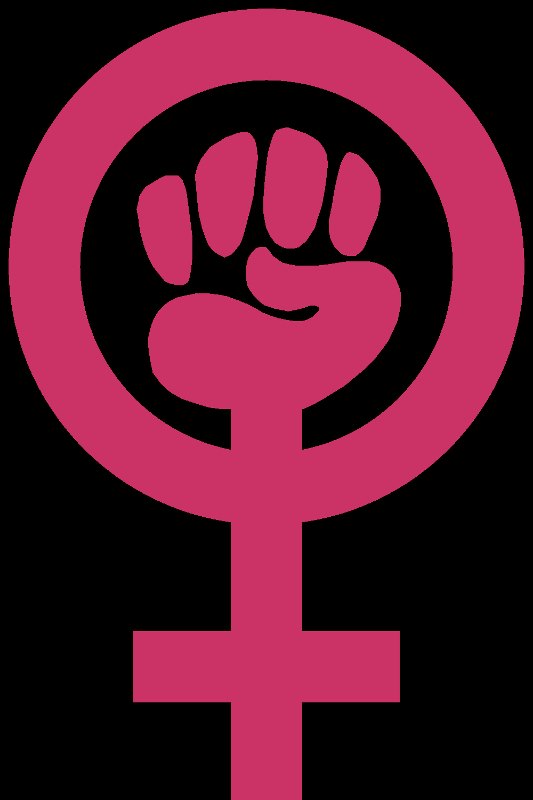As a father with two daughters, I’m keen that they grow up knowing that they should be willing and able to stand up for themselves. Not, of course, that this should actually be necessary. That women and men should be treated in the same manner shouldn’t even be something I have to discuss. In an ideal world I wouldn’t have to. In this one, I do. Because sometimes the girls are going to have to battle to get what they should already have. And that means explaining feminism to my daughters.
It seems an appropriate time to be doing so, what with 2018 being the centenary of some women getting the vote. On that note, I’ve just realised that next year, Emma will become eligible to vote. Wow! Where does the time go?
And so, although the girls will have all the voting rights they’ll ever need, not all playing fields are that level. Some of these playing fields they might have to level themselves. There’s a long history of women having to do things like that, the process of which is known as feminism. This means that the girls are likely to need to be feminists. To do that, they need to understand feminism. But, for me to be explaining feminism to the girls, I first need to understand feminism.
It was at this point that everything started getting complicated…
I’ll start with the definition from Wikipedia:
Feminism is a range of political movements, ideologies, and social movements that share a common goal: to define, establish, and achieve political, economic, personal, and social equality of sexes.
Immediately comes the notion that there is a wide variety of approaches, which makes explaining feminism more difficult than I’d been hoping. But then, the idea of feminism has been around for a long time now, so what else could I expect?

The word feminism was added to the Oxford English Dictionary in 1895. By which time, the word feminist had already been in there for more than 40 years. The French philosopher, Charles Fourier, is credited with coining the phrase in 1837. Since this time, feminism has moved forward in waves.
I should probably point out, at this stage, that I’ll only be talking about feminism as it unfolded and exists in Western societies. I’m fully aware that there are forms and histories of feminism in other societies and cultures. My daughters, though, live in the UK, so, when explaining feminism to them, it seemed sensible to concentrate on what they were most likely to experience. Plus, they’ll only put up with so much of my crap before the pull of the internet becomes too much for them to bear…
The first wave of feminism became known as, First-Wave Feminism. The first wave was around from the mid 1800s to the early 1900s. The drive of first-wave feminism was to end the official, legal inequalities between men and women. It addressed issues like:
- Voting rights (suffrage)
- Custody rights (for women to have custody of their children)
- Property rights (for women to own land)
- Business rights (for women to own businesses)
Second-Wave Feminism took root after the Second World War and gained momentum in the early 1960s. The second wave sought to tackle the societal attitudes towards women, that placed them second to men. Some of these changes were so normalised that changing them also required changes in laws. It challenged things like:
- Domestic violence and marital rape
- Domesticity in marriages
- The right, ability and availability to work
- Contraception and reproductive rights
- Custody laws
- Divorce laws
Third wave feminism is when things started getting confusing. For a start, while explaining feminism to them, I had to introduce the girls to the phrase ‘Feminist Sex Wars’! This was because third wave feminism was born of the Feminist Sex Wars, when the new generation took issue with the 60s version of feminism. The third wave emerged in the 1990s and was based more about individualism and diversity. It wanted to redefine what it was to be a feminist. As to what it stood for, the feminist scholar Elizabeth Evans is quoted as saying that the, “confusion surrounding what constitutes third-wave feminism is in some respects its defining feature.” This, to me, is not particularly helpful. In general, though, the third wave focused on:
- Gender stereotypes
- Sexual harrassment
- Challenging societal norms
- Challenging the artificial construct of the male-female binary system
- As well as continuing the efforts to improve the steps taken in the second wave
Fourth-Wave Feminism started in 2012. It is a continuation of what has gone before but driven by social media for the new generation. While explaining feminism to them, this was the bit with which the girls could most associate. The social media and instant news culture brings the ongoing struggle of women, the world over, to the global consciousness. This has led to a sense, from present day feminists, that; I can’t believe these attitudes can still exist. The focus of the fourth wave seems characterised by campaigns and hashtags:

- The Me Too Movement
- The 2017 and 2018 Women’s March
- The Everyday Sexism Project
The focus seems more on refining the work that has gone before, to get rid of prevailing harassment and objectification.
To complicate matters further, there is post-feminism, which also emerged from the feminist sex wars. Post-feminism works on the principle that the goals of the second wave have been achieved and that the need for feminism, per se, is over. Post-feminism works on the principle that there no longer needs to be a focus on gender and that society should advance as one.
Explaining feminism to my teenage daughters, then, should be easy… Just the four waves of feminism and post-feminism to discuss. There was also what is described as protofeminism, which existed before the waves started. But, from my point of view, I don’t have to worry about protofeminism, because there’s nobody left from that time.
The reason I mention this is that, in Wikipedia, all these waves have a start date and a stop date. The second wave, for example, started in the 60s and finished in the 90s. The implication being that at some point in, say, 1995, all feminists switched to the third wave and all happily agreed with each other.
Sadly, this is not the case. In reality, the feminism that a person was exposed to, in their formative years, is quite often the feminism they carry with them for life. For a dad, explaining feminism to his daughters, this is a problem.
Emma and Ceri, then, are experiencing their formative years in the fourth wave. Their mum, Julie, would have been influenced by the change from the second to third wave. My mum, would have been influenced by the change from the first to the second wave.
All of these women are strong-minded people. They all have drawn, or will draw, from the relevant tenants of feminism, as dictated by the time they experienced them. All of them could, or will, consider themselves to be feminists.
The problem is that some of these waves of feminism are so disparate, that they resulted in ideological wars of words. Yet, all involved would justifiably describe themselves as feminists.
I, too, have always considered myself something of a feminist. I’m very much in favour of equality in all it’s forms. My own brand of feminism, however, struggles with one of the prevailing tropes of current feminism: that feminism is as much for men as it is for women. It’s for everyone.
To me, this is counter-intuitive. Take the example of left handed and right handed people. If a movement was started to promote equality between lefties and righties, and this movement was called right-handedism, this, too, would be counter-intuitive. You’d expect it to be called either-handism, or some such. Of course, some people will claim that they’re neither lefties or righties… or that they’re both… but then, there are always people like that.
The difficulty for me, in this matter, is that the logical choice, humanism, is already in use. Humanism is focused on secularism, atheism and nontheism. As such, it cannot be used as a platform for gender equality. This holds open the door, somewhat, for the ‘feminism is for everyone’ argument.

For me, though, this argument waters down the focus of the feminism that I’ve grown up with. Ironically, though, as I write this, it occurs to me that, as a man; my having opinions on the matter kind of supports the very point that I’m arguing against: that feminism is for everyone. My brain hurts!
Anyway, I decided to ask my mum, my wife and each of my daughters the question, “What can you tell me about feminism?”. With a follow up of, “What else?” where needed.
These were the responses:
Emma (age: 16)
That men and women should be equal.
But it’s often misconstrued as women believing they should be more powerful than men.
Ceri (age: 15)
Feminists want equal rights between men and women. There is extreme feminism where women want more than men.
Feminism is a good idea. There should be equal rights and equal pay based on ability. Everyone should be treated the same, and women shouldn’t have more than men.
Julie (age: younger than me)
It’s about wanting equal rights and pay but also about women generally being treated fairly.
Mum (age: none of your business)
It concerns women. It’s such a muddle, though. These days you hardly dare mention it in case someone takes offence.
It used to be quite nice to get treated with a little respect; having doors held open and men giving up their seats in trains and buses. That’s all gone now, it’s not the men’s fault, they can’t do it in case someone has a go.
Feminism has been really important. In the old days women were treated like chattel. They were chattel. And pay should be equal, if it’s deserved.
The problem is that the pendulum has swung too far the other way. But it’ll all settle down in the end.

For me, it’s interesting to see the evolution of feminism present in the responses. Mum remembers the halcyon days of the second wave, when women started getting more equality but were still able to enjoy the societal norms of male gallantry.
This ability to take the good with the good was stamped out by the third wave, which sought to establish that men and women shouldn’t just be treated the same; they were the same.
Both of the girls also voice the suspicion, expressed by my mum, that the pendulum has swung too far. They both say that feminism can be thought of as an attempt for women to be more powerful than men. The same sentiment was widely expressed at the start of the third wave. No doubt, it will also be present at the start of the fifth wave, whenever that might be.
But then, neither of the girls have experienced sexism. Neither, too, to any extent, has Julie. When the #metoo moment happened, Julie felt unable to participate because she’d never experienced sexual harassment. This made explaining feminism more difficult; not having a first hand account of sexism, sexual discrimination or sexual harassment to draw on.
Further to that, Julie is the owner and boss of G & L Consultancy Ltd, an asbestos management company that employs more than 75 people. I, for my part, have been a stay at home dad and house husband for years. None of us are in any doubt of who rules the roost around here.
This isn’t to say that the girls don’t need to know about feminism. Of course they do. But one is planning to be a doctor, the other a vet and their mum owns a thriving business. I’m not sure that they, necessarily, see the need to campaign for women’s rights. What else is there?
Sadly, I’m sure they’ll find out when they start going out more. Or when they go to university. Or when they start work. There is still plenty of work to be done on certain societal and cultural norms. Explaining feminism is one thing, living it is another. That said, they might get lucky. Like their mum. They might never feel sexually harassed. Only time will tell. In the mean time, they need to stay aware of their version of feminism: fourth-wave feminism.
The problem with fourth-wave feminism is that it’s fed by social media and the internet. It is well recognised that we are living in a period of maximum misinformation, what with fake news and the desire to go viral.
The reliance of the fourth wave on these platforms is not without its issues. The emergence of ‘Toxic Masculinity’ is one such issue, as is the impact all this has on equality. I will be addressing both of these things in due course.
But I will also be showing the girls how to fact check what they read online. Because with feminism, as with everything else, if you can’t get to the truth of the matter, you can’t find your way.
In explaining feminism to the girls I feel I have, at least, helped them understand their place in the history of feminism. And we all agree that, while the need for active feminism is less now than it used to be, it still exists. If only to ensure that things don’t start heading back the way they came.
